Pyramidal Crystal Column Arc Display
Pyramidal Crystal Column Arc Display: Exploring Unusual Atmospheric Optics Phenomena
Atmospheric optics never cease to amaze us with their variety and complexity. One such captivating phenomenon is the pyramidal crystal column arc display. While circular halos are commonly observed due to tumbling pyramidal ice crystals, there are rare instances when these crystals are oriented in a way that produces unique arcs and shapes. In this article, we will delve into the fascinating world of pyramidal crystal column arcs and explore the factors that contribute to their formation.
Understanding Crystal Orientation and Halo Formation
To appreciate the rarity of pyramidal crystal column arcs, it is important to understand the typical behavior of ice crystals in the atmosphere. When ice crystals tumble in clouds, they tend to form circular halos, such as the well-known 22° halo. This orientation is a result of air resistance and the crystals' rounded shape. However, some crystals deviate from this pattern and exhibit elongated or plate-like shapes, which can lead to the formation of what are known as "odd radius" halos.
While most halos are formed by crystals precisely oriented by air resistance as they descend through the atmosphere, pyramidal ice crystals often tumble due to their aerodynamically rounded shape. Nevertheless, there are exceptional cases when these crystals are sufficiently elongated or plate-shaped to become partially oriented. This partial orientation gives rise to the unique pyramidal crystal column arcs that captivate observers.
The Nature of Pyramidal Crystal Column Arcs
Pyramidal crystal column arcs are classified as "contact arcs" because they touch the circular halo produced by the same ray path. The angle at which these arcs appear depends on the crystal's orientation and shape. Konrad Winiarski's display, for instance, showcased column arcs at 9°, 20°, 22°, 24°, and even an extraordinary 35°. The 22° arc, in particular, corresponds to the common circumscribed halo produced by the crystal's central hexagonal prism.
It is worth noting that pyramidal crystal column arcs are exceedingly rare due to the specific conditions required for their formation. The crystals involved are predominantly columnar, with their long axes oriented horizontally. This unique alignment allows the arcs to manifest and adds a touch of wonder to the atmospheric optics display.
Visualizing Pyramidal Crystal Column Arcs
While witnessing pyramidal crystal column arcs in person is a truly remarkable experience, we can also simulate and visualize these phenomena through ray tracing simulations. By using software like HaloSim, researchers can input crystal parameters and solar altitudes to generate virtual representations of the arcs. These simulations help us better understand the intricate interplay between crystal orientation, sunlight, and atmospheric conditions that give rise to these captivating displays.
In a ray tracing simulation for a solar altitude of 40°, a crystal with a tilt standard deviation of 5° was used as an example. However, it is important to note that pyramidal column crystals often exhibit more pronounced wobbling than what was simulated. This variability in crystal behavior further contributes to the rarity and unpredictability of pyramidal crystal column arcs.
Conclusion
The pyramidal crystal column arc display is a mesmerizing atmospheric optics phenomenon that showcases the intricacies of crystal orientation and shape. While most ice crystals tumble and produce circular halos, the exceptional cases where pyramidal crystals become partially oriented result in unique arcs and shapes. These contact arcs, such as the 9°, 20°, 22°, 24°, and 35° column arcs observed by Konrad Winiarski, add an element of intrigue and beauty to our understanding of atmospheric optics.
Through ray tracing simulations, we can visualize and study the formation of pyramidal crystal column arcs, shedding light on the complex interplay between crystal orientation, sunlight, and atmospheric conditions. However, the rarity and variability of these displays make them all the more captivating and elusive. As we continue to explore the wonders of atmospheric optics, the pyramidal crystal column arc display serves as a reminder of the endless surprises nature has in store for us.
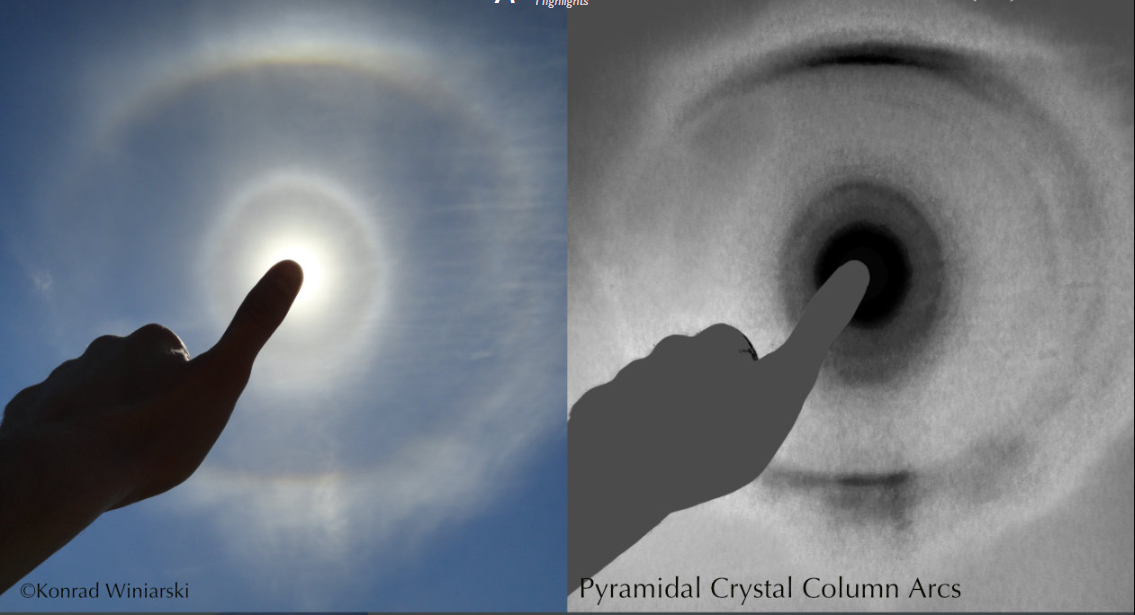
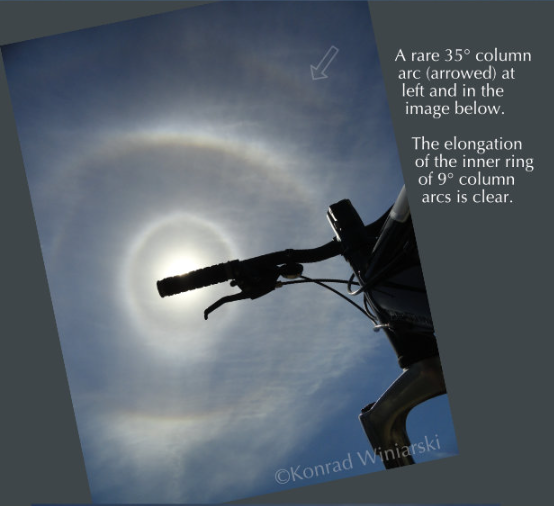
A rare 35° column arc (arrowed) at left and in the image below.
The elongation of the inner ring of 9° column arcs is clear.
Konrad Winiarski
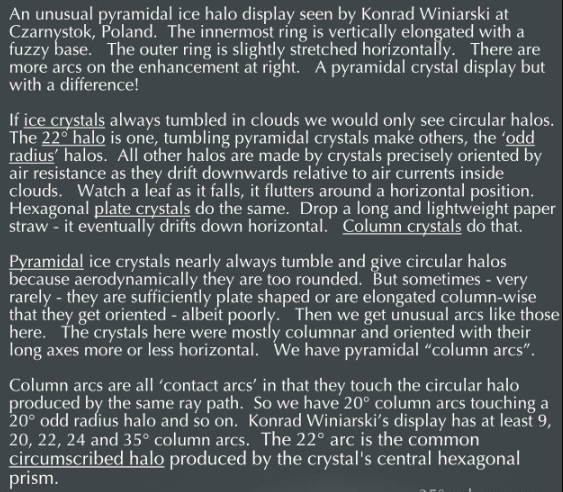
An unusual pyramidal ice halo display seen by Konrad Winiarski at Czarnystok, Poland. The innermost ring is vertically elongated with a fuzzy base. The outer ring is slightly stretched horizontally. There are more arcs on the enhancement at right. A pyramidal crystal display but with a difference!
If ice crystals always tumbled in clouds we would only see circular halos. The 22° halo is one, tumbling pyramidal crystals make others, the 'odd radius' halos. All other halos are made by crystals precisely oriented by air resistance as they drift downwards relative to air currents inside clouds. Watch a leaf as it falls, it flutters around a horizontal position. Hexagonal plate crystals do the same. Drop a long and lightweight paper straw - it eventually drifts down horizontal. Column crystals do that.
Pyramidal ice crystals nearly always tumble and give circular halos because aerodynamically they are too rounded. But sometimes - very rarely - they are sufficiently plate shaped or are elongated column-wise that they get oriented - albeit poorly. Then we get unusual arcs like those here. The crystals here were mostly columnar and oriented with their long axes more or less horizontal. We have pyramidal "column arcs".
Column arcs are all 'contact arcs' in that they touch the circular halo produced by the same ray path. So we have 20° column arcs touching a 20° odd radius halo and so on. Konrad Winiarski's display has at least 9, 20, 22, 24 and 35° column arcs. The 22° arc is the common
circumscribed halo produced by the crystal's central hexagonal prism.
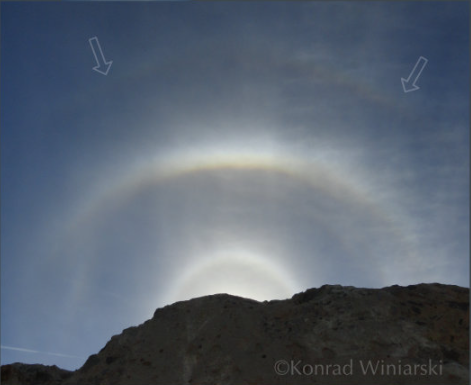
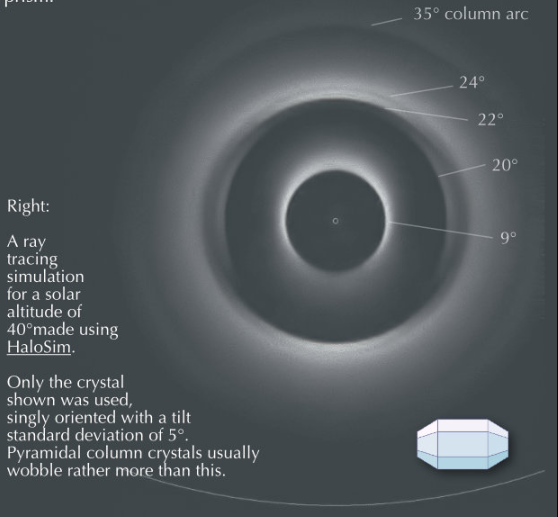
Right:
A ray tracing simulation for a solar altitude of 40°made using HaloSim.
Only the crystal shown was used, singly oriented with a tilt standard deviation of 5°. Pyramidal column crystals usually wobble rather more than this.
Note: this article has been automatically converted from the old site and may not appear as intended. You can find the original article here.
Reference Atmospheric Optics
If you use any of the definitions, information, or data presented on Atmospheric Optics, please copy the link or reference below to properly credit us as the reference source. Thank you!
-
<a href="https://atoptics.co.uk/blog/pyramidal-crystal-column-arc-display/">Pyramidal Crystal Column Arc Display</a>
-
"Pyramidal Crystal Column Arc Display". Atmospheric Optics. Accessed on November 15, 2024. https://atoptics.co.uk/blog/pyramidal-crystal-column-arc-display/.
-
"Pyramidal Crystal Column Arc Display". Atmospheric Optics, https://atoptics.co.uk/blog/pyramidal-crystal-column-arc-display/. Accessed 15 November, 2024
-
Pyramidal Crystal Column Arc Display. Atmospheric Optics. Retrieved from https://atoptics.co.uk/blog/pyramidal-crystal-column-arc-display/.